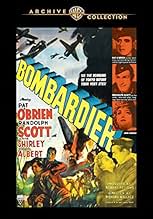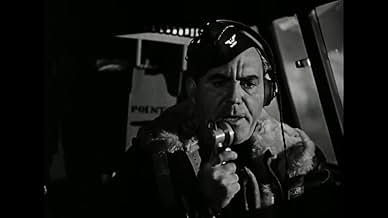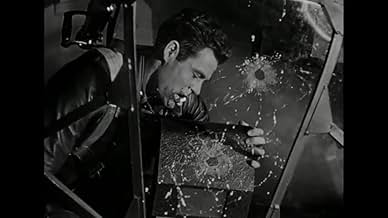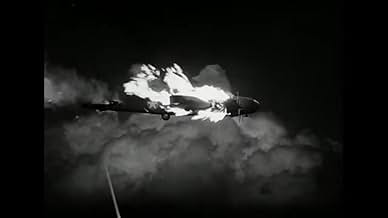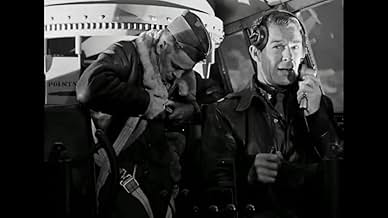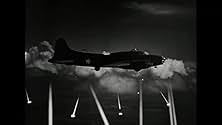VALUTAZIONE IMDb
6,0/10
931
LA TUA VALUTAZIONE
In una base di addestramento per bombardieri di alta quota dell'aeronautica americana, le vicende militari ed umane di ufficiali, cadetti e personale femminile. Poi la guerra.In una base di addestramento per bombardieri di alta quota dell'aeronautica americana, le vicende militari ed umane di ufficiali, cadetti e personale femminile. Poi la guerra.In una base di addestramento per bombardieri di alta quota dell'aeronautica americana, le vicende militari ed umane di ufficiali, cadetti e personale femminile. Poi la guerra.
- Regia
- Sceneggiatura
- Star
- Candidato a 1 Oscar
- 1 vittoria e 1 candidatura in totale
Eugene L. Eubank
- General Eubank
- (as Brigadier-General Eugene L. Eubank)
Murray Alper
- Little Boy - Spy
- (non citato nei titoli originali)
Stanley Andrews
- Congressman
- (non citato nei titoli originali)
Joan Barclay
- Buck's Secretary
- (non citato nei titoli originali)
Hugh Beaumont
- Soldier
- (non citato nei titoli originali)
Recensioni in evidenza
There were a lot of films made by Hollywood during the war years that were designed to drum up support for our troops from the public. Seen today, some might dismiss them or just see them as propaganda--which they technically are, but of a positive sort and meant to unify the nation. This film is a pretty effective and entertaining example of the genre--having a pretty realistic script and good production values. Pat O'Brien plays pretty much the same character he played in MANY other films (you know, the tough-talking, hard-driven but "swell guy"). Randolph Scott is, as always, competent and entertaining and the rest of the extras are excellent (look for a young Robert Ryan as one of the bombardiers in training). While the story is reminiscent of several other movies about our pilots and crews, the film is well-crafted enough to make it interesting and not too far-fetched. That it, perhaps, except for the very end--where the film is a bit over-the-top but also VERY satisfying. About the only serious negative, and this is mostly for nitpickers, is that some of the stock footage is somewhat sloppily integrated in the film and "nuts" like me who are both history teachers and airplane lovers will probably notice this--all others probably won't notice.
Made in 1942, before the allies had the upper-hand in Europe, 'Bombardier' is part entertainment, part propaganda, and part recruiting film. The film follows the establishment of a Bombardier Training School, championed by Major "Chick" Davis (Pat O'Brien), a firm believer in high-altitude precision bombing and criticized by his buddy, Capt. "Buck" Oliver (Randolph Scott), a pilot-oriented proponent of low-level drops and dive-bombing. As the film opens with (the real) Brigadier General Eugene L. Eubank extolling the critical role of the bombardier in the ongoing war, there is little doubt which of the two offensive strategies is going to win out. Typical of the genre, the film follows a diverse group of trainees, from their arrival at the school to their baptisms in fire, with some romantic filler and dated comic-relief thrown in. Even by wartime standards, the film is pretty heavy handed. There is a particularly egregious sequence in which a trainee admits that he is uncomfortable with dropping high-explosives on targets where there may be non-combatants (including women) and that his mother had written him a letter expressing her concerns that he was training to be a murderer. The chaplain explains to him (and indirectly to the audience, which might include people of similar opinions to the fictional mother), that the bombardier is doing God's will by bombing the German military-industrial infrastructure. During the war Americans celebrated "Rosie the Riveter", who represented the women who worked in the factories thereby freeing-up men to fight, and as there would be no reason to believe that women in the Axis powers weren't doing the same, people must have accepted the fact that women could be killed when the factories were bombed (as were, as was later discovered, forced laborers). The film contains is lots of great aircraft footage, especially of the Douglas B-18 Bolo (which would have been obsolete when the film came out) and of the iconic B17 'Flying Fortress'. I particularly liked the well-done special-effects footage of Japanese fighters attacking a formation of five B17s, which bring the massive firepower of their dozens of .50 calibre machineguns to bear, annihilating the attacking fighters. This prodigious defensive firepower gave the plane its nickname but in reality was not sufficient to ward off attacks by faster and more nimble fighters (as the USAF found out at great cost over Germany in 1943). The rest of the special effects are hit and miss, there are some good pyrotechnic scenes as the bombs bullseye Japanese targets but the earlier B18 model work is substandard, even for the times. The cast is fine in what is essentially a propaganda picture, there are lots of gorgeous, soldier-loving, dames to entice young men in the audience to sign-up, and a thrilling but typically far-fetched heroic climax. OK for an unsubtle WW2 morale-booster/recruitment film (especially if you like planes) but not in the same league as the excellent "30 Seconds over Tokyo" (1944).
Pat O'Brien takes his Knute Rockne character and joins the Army Air Corps in Bombardier and he and Randolph Scott have a disagreement as far as air tactics go. Scott wants to do things as they do in the RAF where he's been an observer. Fly in low and drop bombs and avoid being shot at.
O'Brien is more interested in technology. Develop and learn how to use an accurate bombsight so you can be up around 20,000 feet and only have to worry about enemy planes which presumably your fighter escort has to deal with.
But since these guys are friends it's a good natured fight as both are in the business of training bombardiers. Among the familiar faces they train are Eddie Albert and Robert Ryan before both went in the service themselves.
Bombardier is so very dated now, but still entertaining. The advances in technology are light years beyond what O'Brien and Scott are dealing with. Film buffs who are air historians might like it though.
O'Brien is more interested in technology. Develop and learn how to use an accurate bombsight so you can be up around 20,000 feet and only have to worry about enemy planes which presumably your fighter escort has to deal with.
But since these guys are friends it's a good natured fight as both are in the business of training bombardiers. Among the familiar faces they train are Eddie Albert and Robert Ryan before both went in the service themselves.
Bombardier is so very dated now, but still entertaining. The advances in technology are light years beyond what O'Brien and Scott are dealing with. Film buffs who are air historians might like it though.
This 1943 film by RKO is among several that Hollywood and/or the War Department put out during the early months and years of World War II. It's a mix of genres. The war action comes at the end. A docu-drama style tells the story of the bombardier school and training. Hollywood adds its usual touch of romance, but lightly. The drama is there – even in the training. And, of course, it's a propaganda film. Propaganda surely had its place in WWII – to help sustain public morale, build support for the U.S. cause and efforts, and give the public a picture of some of the troops, training, and campaigns.
"Bombardier" tells and shows us the early days of training for this new position in the Army Air Forces – precursor of the U.S. Air Force. As such, it's a good educational piece for the public, then and now. The men who went into combat in different roles weren't tossed together and sent into combat. They were trained first. And for some fields, the training was highly specialized and detailed. This film shows very well that detail, study and science that went into the training of bombardiers. These men indeed played a critical role in destroying enemy armament production, fuel depots and major supplies – and in so doing, helped end the war much earlier than it would have otherwise concluded.
Many have said it since the first attribution to Civil War Gen. William T. Sherman, that "War is hell!" But once a nation is in a war, it should do everything possible to end it as soon as possible.
Many war movies have been made, especially about the two "great" world wars of the 20th century. They have variously focused on the action of troops in battles, assaults from the sea, naval engagements or air combat. Most give us a picture, however much Hollywood may "tweak" it, of the human conditions, relationships, and characters. Often times they include the strategic plans of real battle scenes. These are the things that most interest people, or "entertain" audiences for this genre. But films such as "Bombardier" add another value in educating and informing the public of what went into the readying of our nation for war, and our ability to win and end it as soon as possible.
As an Army paratrooper veteran, I enjoy learning about the "how-to" that men and women learn in the different combat and support specialties of our armed services. People who approach war movies in a similar frame of mind will be much more likely to enjoy them. I highly recommend "Bombardier" as an informative, action-filled and historical war movie.
"Bombardier" tells and shows us the early days of training for this new position in the Army Air Forces – precursor of the U.S. Air Force. As such, it's a good educational piece for the public, then and now. The men who went into combat in different roles weren't tossed together and sent into combat. They were trained first. And for some fields, the training was highly specialized and detailed. This film shows very well that detail, study and science that went into the training of bombardiers. These men indeed played a critical role in destroying enemy armament production, fuel depots and major supplies – and in so doing, helped end the war much earlier than it would have otherwise concluded.
Many have said it since the first attribution to Civil War Gen. William T. Sherman, that "War is hell!" But once a nation is in a war, it should do everything possible to end it as soon as possible.
Many war movies have been made, especially about the two "great" world wars of the 20th century. They have variously focused on the action of troops in battles, assaults from the sea, naval engagements or air combat. Most give us a picture, however much Hollywood may "tweak" it, of the human conditions, relationships, and characters. Often times they include the strategic plans of real battle scenes. These are the things that most interest people, or "entertain" audiences for this genre. But films such as "Bombardier" add another value in educating and informing the public of what went into the readying of our nation for war, and our ability to win and end it as soon as possible.
As an Army paratrooper veteran, I enjoy learning about the "how-to" that men and women learn in the different combat and support specialties of our armed services. People who approach war movies in a similar frame of mind will be much more likely to enjoy them. I highly recommend "Bombardier" as an informative, action-filled and historical war movie.
I wasn't sure at first if I was watching a documentary, propaganda film or dramatic presentation. I guess given the time of production it was a mix of all three.
Admittedly the dramatic plot was somewhat predictable. But you had a sense that there would be some interesting scenes as the movie went on. We were able to witness what appeared to be realistic training regimens and equipment.
Where this movie came together for me was closer to the end. The scenes had a realism (at least as I perceived it) that I haven't encountered often before. You could place yourself in the action and imagine the thoughts of the young combatants. This was mixed in with the usual problems of portraying passable Japanese soldiers at a time when you might think real Japanese actors would be somewhat scarce.
The movie is excellent as a source of the state of the American mindset in 1943 as the war waged with Japan. Also of interest was a dig at the Japanese with respect to the help the USA gave Japan in past years.
Admittedly the dramatic plot was somewhat predictable. But you had a sense that there would be some interesting scenes as the movie went on. We were able to witness what appeared to be realistic training regimens and equipment.
Where this movie came together for me was closer to the end. The scenes had a realism (at least as I perceived it) that I haven't encountered often before. You could place yourself in the action and imagine the thoughts of the young combatants. This was mixed in with the usual problems of portraying passable Japanese soldiers at a time when you might think real Japanese actors would be somewhat scarce.
The movie is excellent as a source of the state of the American mindset in 1943 as the war waged with Japan. Also of interest was a dig at the Japanese with respect to the help the USA gave Japan in past years.
Lo sapevi?
- QuizThe American bomb sight mentioned throughout the movie was the Norden bomb sight whose secret was almost as closely guarded as the development of the atomic bomb. It used a mechanical computer and linkage to the plane's autopilot to achieve an accuracy of hitting with 75 feet of the target from an altitude of 12000 feet. All members of the bomber's crew were ordered to destroy the sight at all costs if the plane was going to crash. Many ships carried a hand grenade to place under the sight to assure total destruction. It was used as late as 1967 to drop sensors along the Ho Chi Minh trail in Viet Nam.
- BlooperThe Douglas B18's, Beechcraft AT11's and B17 aircraft all sport national markings found from May 1942 until June 1943, yet a considerable part of this film takes place before Pearl Harbor.
- Citazioni
Burton Hughes: You're quite an entomologist.
Sgt. Archie Dixon: Nope! But I know all about bugs.
- Curiosità sui creditiBrigadier General Eugene L. Eubank is billed first because he is credited in the forward before any cast is mentioned, and he is not listed in the comprehensive end credits.
- Versioni alternativeAlso available in a computer colorized version.
- ConnessioniReferences Addio, mr. Chips! (1939)
- Colonne sonoreSong of the Bombardiers
(1942) (published title)
On-screen title: "Song of the U. S. Bombardiers"
Music by M.K. Jerome (as M. K. Jerome)
Lyrics by Jack Scholl
Played during the opening and closing credits and often in the score
Sung by the audience at the magic show
I più visti
Accedi per valutare e creare un elenco di titoli salvati per ottenere consigli personalizzati
Dettagli
- Tempo di esecuzione1 ora 39 minuti
- Colore
- Proporzioni
- 1.37 : 1
Contribuisci a questa pagina
Suggerisci una modifica o aggiungi i contenuti mancanti

Divario superiore
By what name was 19° stormo bombardieri (1943) officially released in India in English?
Rispondi

